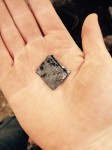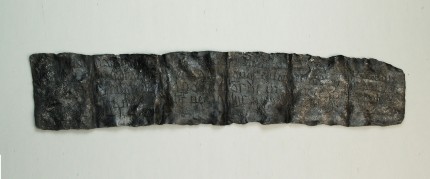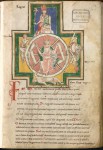 An archaeological excavation in advance of drainage work in Svendborg, a city on the island of Funen in southeastern Denmark, unearthed a medieval amulet invoking both elves and the Triune God of Christianity. It didn’t look like much at first, a small square piece of metal just two centimeters (.8 inches) long and wide, but that’s because it was folded down the short side five times. Once unfolded, it was 13 centimeters (just over five inches) long.
An archaeological excavation in advance of drainage work in Svendborg, a city on the island of Funen in southeastern Denmark, unearthed a medieval amulet invoking both elves and the Triune God of Christianity. It didn’t look like much at first, a small square piece of metal just two centimeters (.8 inches) long and wide, but that’s because it was folded down the short side five times. Once unfolded, it was 13 centimeters (just over five inches) long.
It was discovered on the Møllergade, one of two main roads encircling Svendborg’s old town. Previous excavations of the Møllergade have unearthed layers going back as far as 1150, but the amulet likely dates to the mid-13th century when the road was expanded northward as the city grew. While amulets of this kind have been found elsewhere in Denmark and other Scandinavian countries, this is the first one found in Svendborg.
Metallurgic analysis found that the amulet had a high silver content. The piece of metal was painstakingly unfolded, without damaging the surface, and National Museum of Denmark curator Lisbeth Imer, an expert in inscriptions, examined the interior surface of the amulet under a microscope. She found five lines written in lower case Latin characters by someone with a sure hand and an eye for minute detail. The letters are between two and four millimeters high and are interspersed with crosses for added amulet value.

The translated inscription reads:
I charge you Gordan, Gordin and Ingordan, elf men and elf wives and all demons by the Father and the Son and the Holy Spirit and by all of God’s saints, that you do not harm God’s handmaiden Margareta either the eyes or limbs. Amen. You are great in eternity, Lord.
Gordan, Gordin and Ingordan feature on many wood and metal amulets found in Denmark, Norway and Sweden. Their significance has long been debated by historians, but several medieval manuscripts refer to them as folkloric figures. The Codex Upsaliensis, written in the first quarter of the 14th century, includes the phrase “I invoke you, elves, Gordin and Ingordin.” Carmina Burana, the manuscript of 254 poems and songs of traditional itinerant performers written in 1230, 24 of which would famously be put to music by Carl Orff in 1936, has a song in which Gordan, Ingordin and Ingordan appear as the villains. It’s the 54th piece, known as CB54, and it reads like a warding spell. I’m posting the whole thing because, simply stated, it’s awesome.
Every kind of demon being —
Come hobbling, come squabbling,
Sightless or unseeing —
Mark well my words, my invocation,
My command, my incantation.
Creatures of all phantom company
Who populate the principality
Of that vile dragon creeping
With venom seeping —
Whose high and mighty fundament
Sweeps full one third the stars’ extent —
Gordan, Ingordin and Ingordan:
By the Seal of Solomon,
Magi the Pharaohs call upon,
I now exorcise you
And substantialize you:
By sages three: Caspar,
Melchior and Balthazar:
By David’s playing
For the allaying
Of Saul’s dismaying
And your gainsaying.I adjure you
And conjure you
By the mandate of the Lord:
Be unkind not,
Hurt mankind not,
Manifest misericord:
Show but once your faces
And retract your traces
With forsaken races
To hell’s hiding places.I adjure
I conjure
By that awesome
By that fearsome
That gruesome Judgement Day,
When unending punishment
And horror and dismay
And unbounded banishment
Shall drive demonkind
Into damnation
But shrive humankind
Unto salvation.By that same unnamed, unsaid,
That unutterably dread
Tetragrammaton of God:
Fall to fear and trembling
As to disassembling
I now exorcise
Spectres: demons: ghosts: hobgoblins:
Satyrs: sirens: hamadryads
Nightmares: incubi and
Shades of the departed —
Flee to ruination,
Chaos and damnation,
Lest your foul conflation
Rend Christ’s congregation.From all our enemies, good Lord, deliver us.
 It’s a great example of how Christianity interpreted traditional folk beliefs and ancient religions as a direct threat to the souls and unity of its believers. I imagine Archbishop Gregory II of Agrigento spoke an incantation like this when he cast out the two demons/previous deities from the temple before he converted it into a church, only that was in the late 6th, early 7th century when the corpse of Greco-Roman polytheism was still fresh. Denmark only converted to Christianity in the 10th century, however, so while satyrs, sirens and hamadryads may have been thin on the ground so far up north, elves and trolls were very much in the picture when this song was sung and written down.
It’s a great example of how Christianity interpreted traditional folk beliefs and ancient religions as a direct threat to the souls and unity of its believers. I imagine Archbishop Gregory II of Agrigento spoke an incantation like this when he cast out the two demons/previous deities from the temple before he converted it into a church, only that was in the late 6th, early 7th century when the corpse of Greco-Roman polytheism was still fresh. Denmark only converted to Christianity in the 10th century, however, so while satyrs, sirens and hamadryads may have been thin on the ground so far up north, elves and trolls were very much in the picture when this song was sung and written down.
Amulets provide fascinating glimpses into the long transition. The practice of invoking elves, demons and other assorted types from folklore like giants and trolls dates back to the Iron Age and is consistent even as the dominant religions change. In runic amulets from the Viking era, these creatures appeared next to the gods Thor and Odin. The wearer asked the gods for protection from disease or misfortune as incarnated by the characters from folklore. Once Christianity was established, the old gods were replaced with the new one and His scriptural support staff, but the structure of the invocation remained the same: a prayer asking a deity to prevent evil from befalling a person by calling out the scoundrel types who would do them harm. If said evil has a name, it can be contained and dispelled. Exorcising by substantializing, as CB54 puts it.
 Svendborg was growing rapidly in the 13th century, and large-scale Christian structures were constructed in the burgeoning market town. The Church of Our Lady was built then, as was the Franciscan monastery. The Church of St. Nicholas, originally built of stone in the mid-12th century, was expanded and reconstructed in brick in the 1200s. Institutional growth can’t necessarily speak to the experience of the individual, however. The amulet bridges that gap.
Svendborg was growing rapidly in the 13th century, and large-scale Christian structures were constructed in the burgeoning market town. The Church of Our Lady was built then, as was the Franciscan monastery. The Church of St. Nicholas, originally built of stone in the mid-12th century, was expanded and reconstructed in brick in the 1200s. Institutional growth can’t necessarily speak to the experience of the individual, however. The amulet bridges that gap.
The Svendborg amulet gives a rare insight into how ordinary citizens used Christianity in their daily lives. Long has it been known that the clergy forces were strong in contemporary Svendborg, and now there is also evidence that the faith among ordinary people was strong, says [Svendborg Museum archaeologist] Allan Dørup Knudsen:
“Our knowledge of the townspeople and their daily life in the Middle Ages is unfortunately very limited, but through this amulet we get very close to Margareta and can feel her suffering and prayers for a good and disease free life.”
The amulet has also conferred on Margareta a very cool kind of immortality: she is now the oldest known female resident of Svendborg.